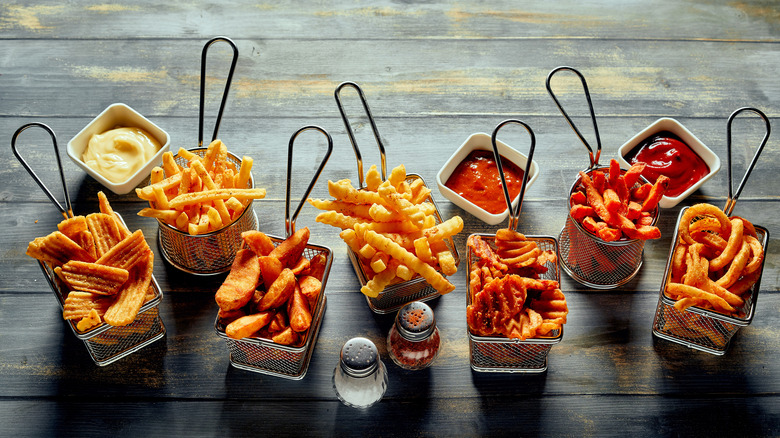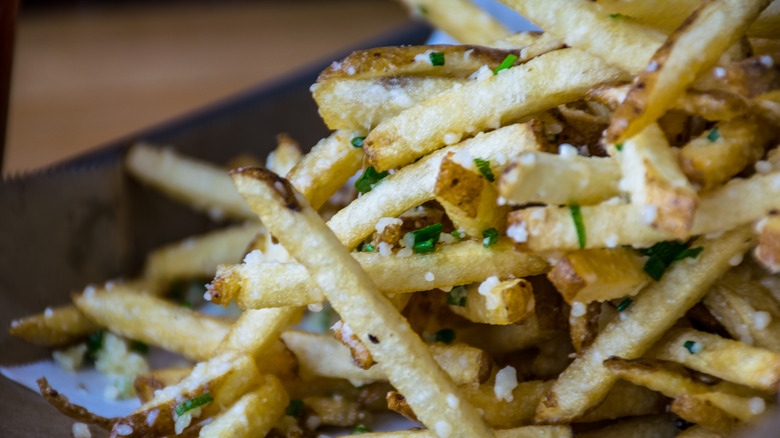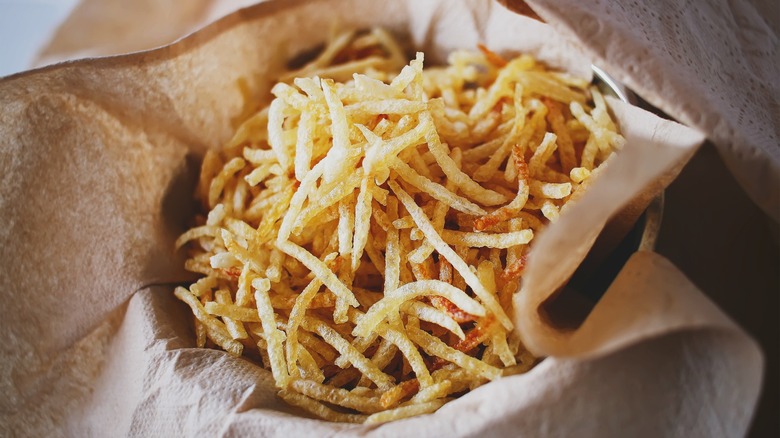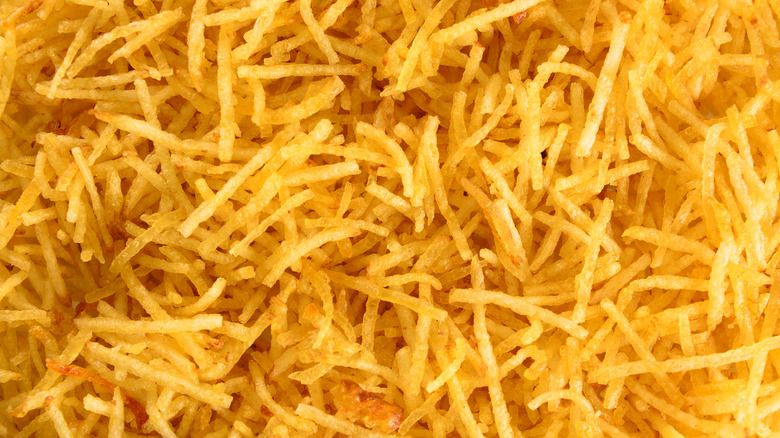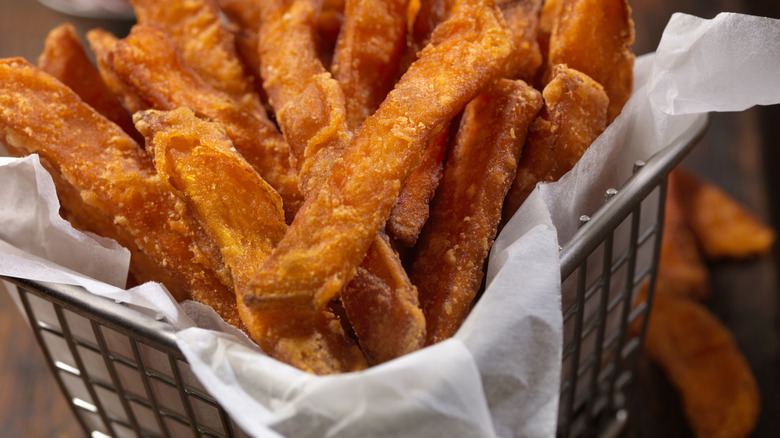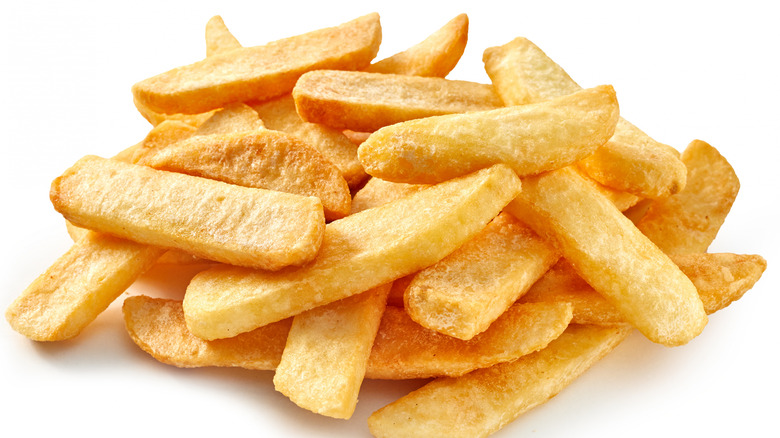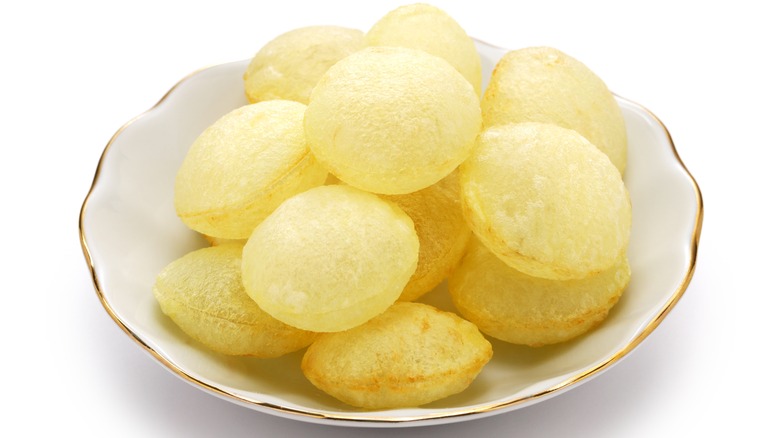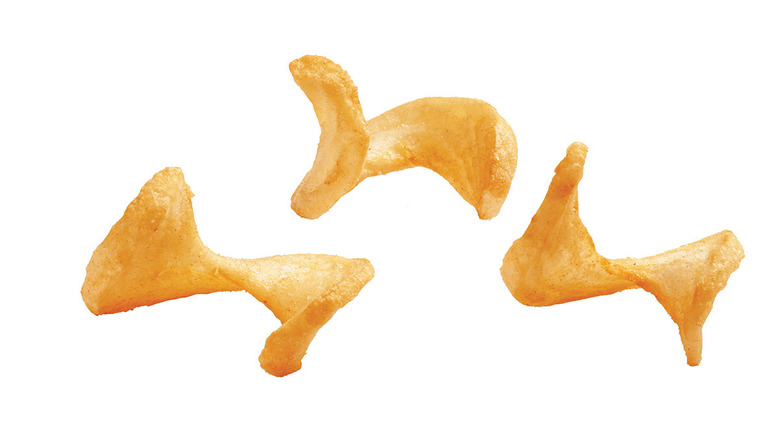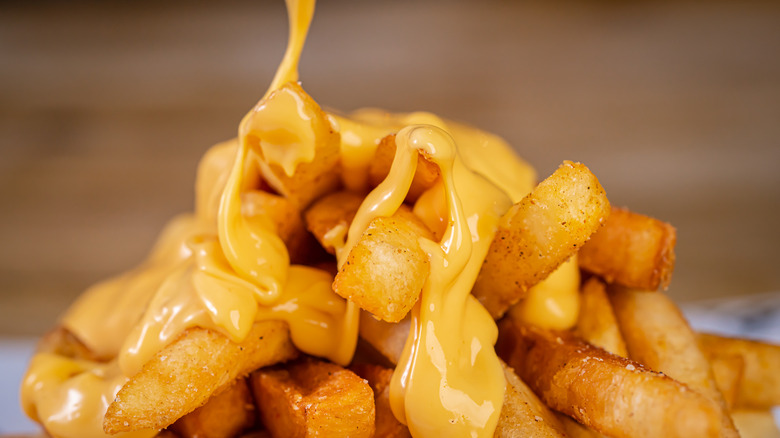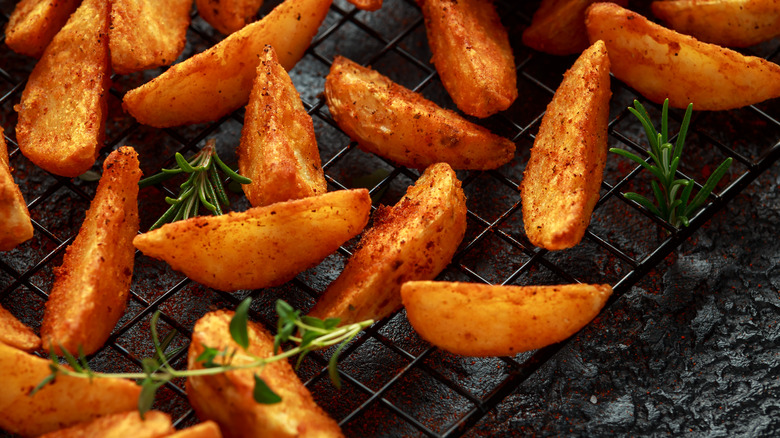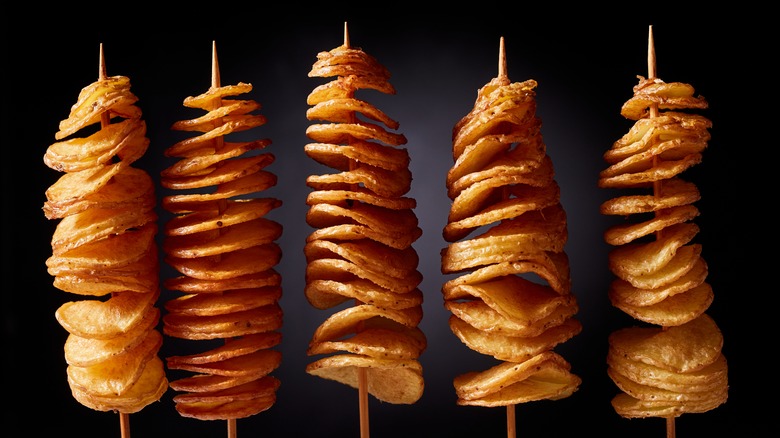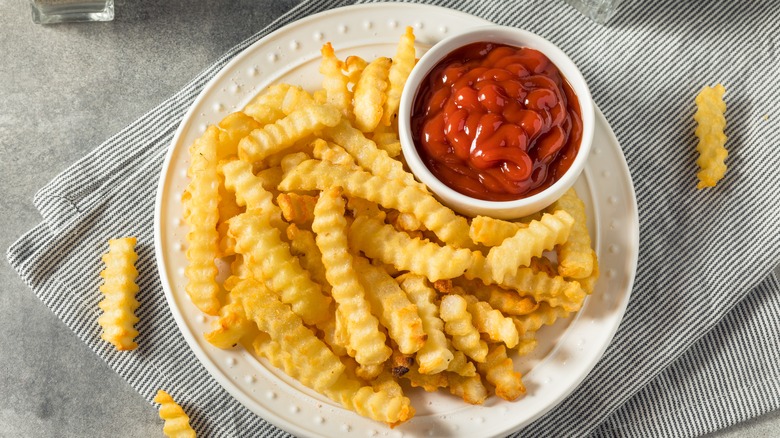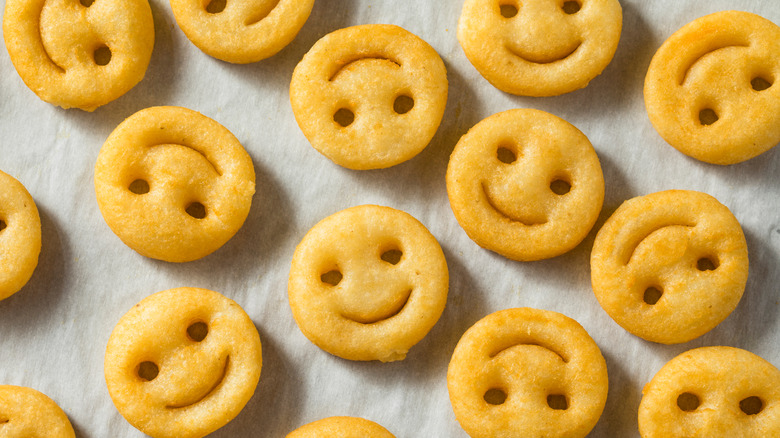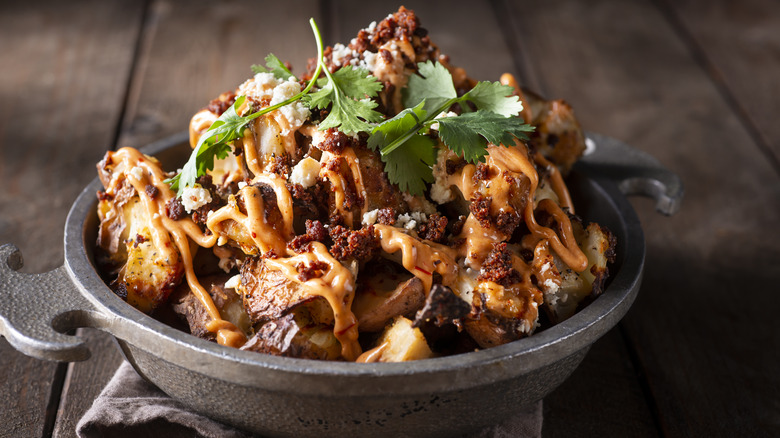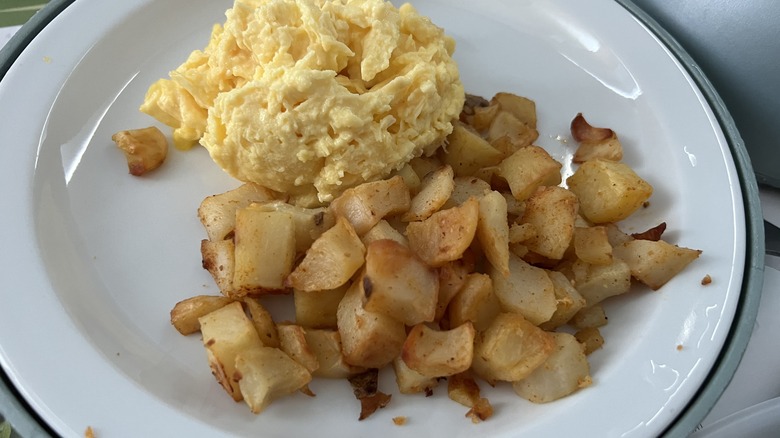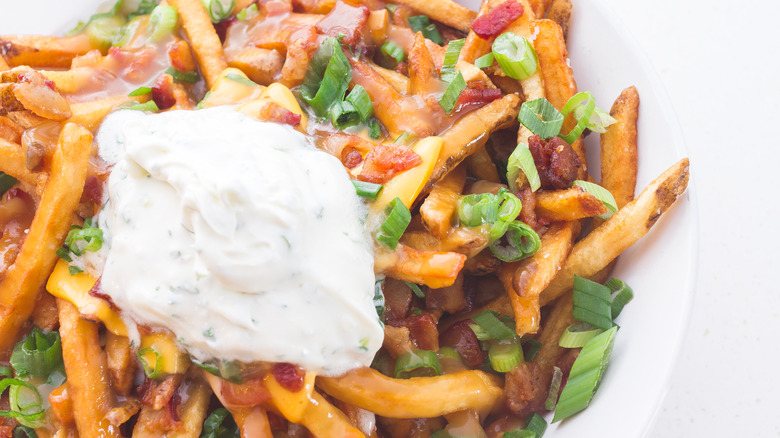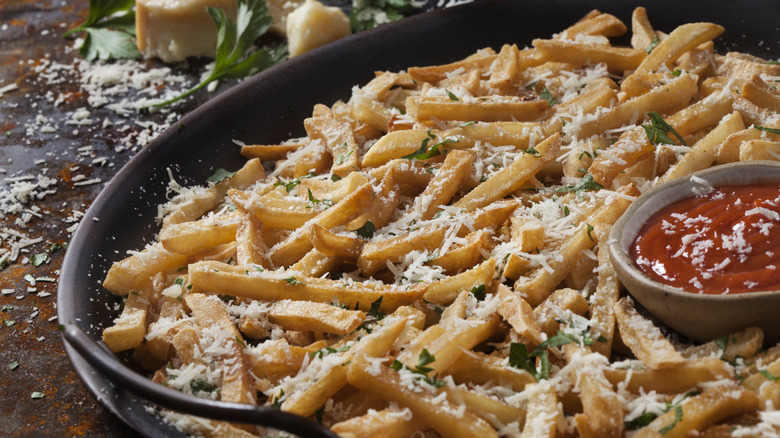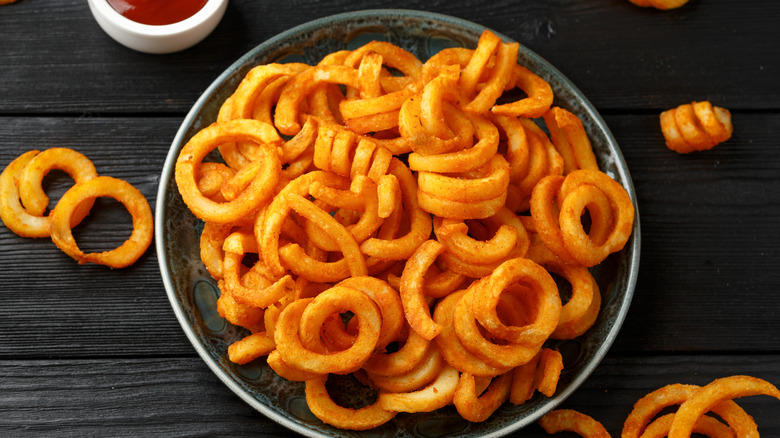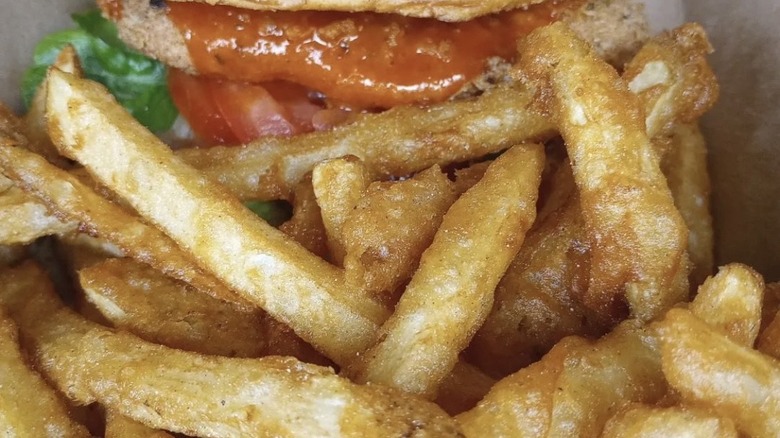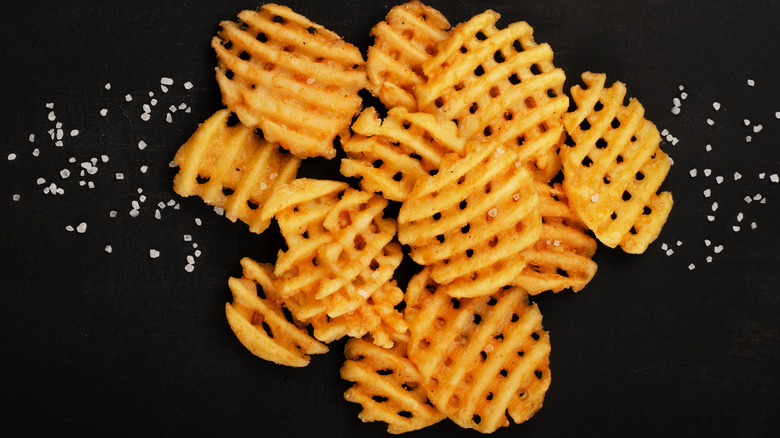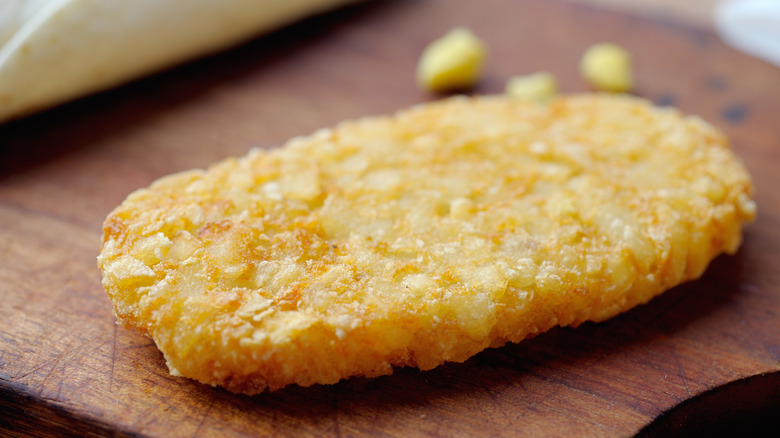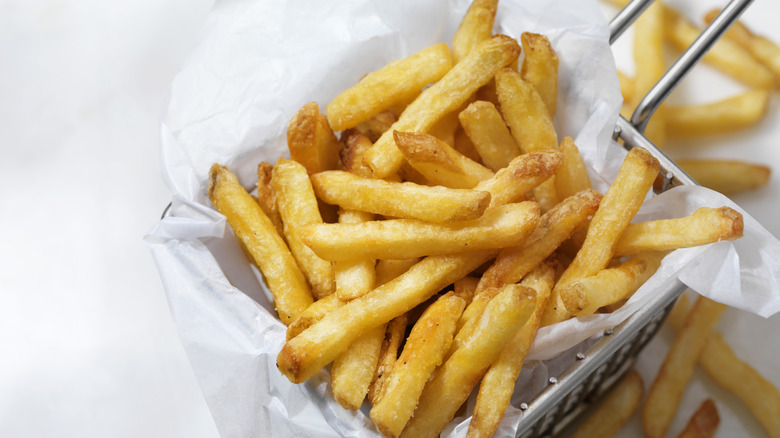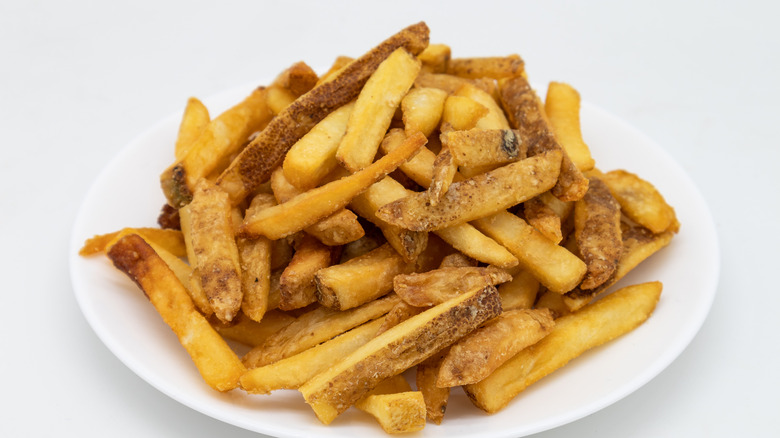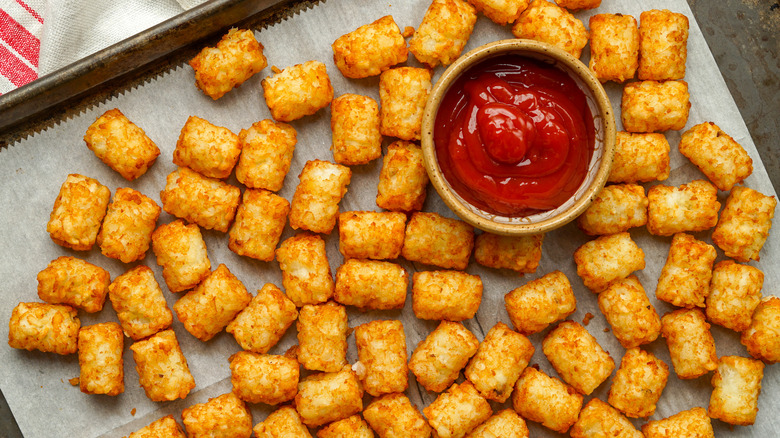25 Types Of Fries, Ranked
It's hard not to love french fries — whether you're guilty of ordering a side of fries with your salad for lunch or digging into your "must-have" bag of frozen tater tots to cure a hangover. The origin of french fries is somewhat disputed, but Belgium is the primary country that lays claim to this classic American side dish. The word "french" comes not from a country but from the frenching technique, which involves julienning the food into small pieces that can be surrounded by heat during cooking.
However, modern french fry preparations (and food processing mechanizations) have evolved to include many different french fry shapes. You will also see an immense geographic variation in the toppings used on french fries, too, since it seems like the whole world is obsessed with these fried potatoes. That begs the question: Are all french fry shapes and variations created equal? We think not. Below, a ranking of the best and worst types of fries.
25. Truffle fries
A food trend that perhaps should have died a few years ago, truffle fries are made with truffle oil, which contains no real truffles and gives the genuine article a bad rap. The flavor is plasticky and reminiscent of dirty socks — especially if the chef decides to drown the fries out with the oil. Moreover, if a chef uses truffle oil on food (including fries), it's likely because they don't know how to season the dish properly.
The only good part about truffle fries is the parmesan and herb garnish alongside which it's often served. Otherwise, these fries are best left off your plate.
24. Matchstick fries
Matchstick fries are cut to the same size as shoestring, but are typically smaller, more uniform shapes that resemble their namesake. Like shoestring fries, you run into some of the same issues with the texture and shape. They are usually too much exterior, not enough interior. Moreover, the slim shape of these fries makes them easy to overcook.
The matchstick fry is a less optimal option than the shoestring because of its smaller size. If you dip it in ketchup it will most certainly drown, while at least the shoestring's long size may allow you to wrap it around a fork and extract it from the condiment.
23. Shoestring fries
Shoestring fries are, very clearly, one of the worst types of fries ever invented. As the name implies, the potatoes for shoestring fries are cut one-eight inch to a quarter inch wide, meaning that they have a high ratio of crispy outside to fluffy inside. This ratio, however, means that shoestring fries tend to get very oily very easily and aren't as satiating as other fry shapes.
The thin shape of these fries does not lend itself to dipping in sides or layering up with cheese or toppings. Functionality is out the window when it comes to this fry shape, unless it's being used as a garnish for some other food.
22. Sweet potato fries
They were a big fad not too long ago, and remain omnipresent on menus, but sweet potato fries simply aren't good. They're soggy, limp, and too mushy to be even be worthy of the "fry" designation.
Although there are probably some sweet potato fry brands out there that can make it work, the sweet potato fundamentally is a poor choice for making fries. Plus, the sweet flavor isn't really compatible with the classic ketchup accompaniment. The only good part about this type of fry is that it can come in different shapes, so it has some utility.
21. Steak fries
The main issue with steak fries is an imbalance of inside to outside. This shape has the opposite problem of a shoestring fry; the amount of fluffy, potato-y inside is too high. This means that steak fries always manage to get soggy quickly — not ideal for eating. At this point, just eat a baked potato.
The redeeming quality of this french fry shape is that it is more structurally sound than other varieties, so you can use it as a base for toppings without worrying about the fry falling apart. However, this necessitates a crisp fry — which never happens with steak fries, anyway.
20. Pommes souffles
Pommes souffles are a French style of making potatoes. These circular coins are fried twice; first at a low temperature to form a crust, the second time to get the characteristic puff on the inside of the fry. The result is a potato with a spectacular texture, unlike any other type of fry out there.
These potatoes are, if anything, a novelty. They require the cook to be very diligent about the temperature and the number of slices that can be fried at once. The result is a lot of effort for a potato that can't really be dipped in anything without losing its aesthetic value.
19. Side-winding fries
Side-winding fries are another niche concept, this one only manufactured by a single supplier: Simplot Foods. These chips have a slight rotating curve and resemble a small piece of a thick-cut tornado fry. Their unique shape is visually appealing and bound to hold a lot of toppings or condiments, but the market for these fries is too small to be considered a true contender — especially when stacked up against other popular fry shapes.
While these fries are fun to eat and scoop toppings with, it's hard to imagine reaching for them to accompany a burger or hotdog when there are much better fry shapes out there.
18. Cheese fries
If you don't like eating canned cheese sauce, you most likely won't be a fan of cheese fries. Although it's easy to appreciate the nostalgia of ordering a basket of these fries from a baseball stadium or beach snack shack, the fries lose their appeal pretty quickly.
The cheese sauce is plasticky (and really lacking in cheese flavor, honestly) and only serves to make the fries soggy — which negates the use of crispy fries anyway. Plus, cheese fries need to be eaten within a short window before the cheese sauce starts to congeal, limiting their utility.
17. Wedge-cut fries
Potato wedges are thick-cut fries often made from whole potatoes. Since this fry is thicker than other varieties, it tends to have a lot of fluffy potato interior compared to other fries. Since the skin is often left on with this cut, you should expect that some of the wedges will be crispier than others. Failing to cut the potato wedges to a uniform size will also result in more headache than it is worth, because there will always be a part of the wedge that is slightly undercooked.
The soggiest of these fries are typically the ones baked rather than fried, meaning these wedges should be considered more roasted potatoes than french fries.
16. Potato tornado
Potato tornados are essentially fair food that has made its way into the french fry lexicon. You can use a spiralizer for butterfly-style potato chips and slice your strips into whatever thickness you desire for these fries.
Overall, this potato variety has a ton of aesthetic appeal nestled inside of its folds, as well as a high surface area to cover with toppings and condiments. But this cut of french fry is still somewhat underground compared to other, more popular styles. It seems to have become a popular boardwalk food sometime around the late 00's, but hasn't really broken through beyond that, and remains rarely seem in restaurants or home kitchens.
15. Crinkle-cut fries
It's hard to understand what the fascination is with crinkle-cut french fries. You have to have a specialized cutter to make them at home, so they are rarely the norm. Nevertheless, favorite fast food destinations like Shake Shack and Raising Canes have chosen to make crinkles their go-to fry style.
These companies have figured out how to get the perfect crinkle-cut texture, which is commendable; the rest of us are left scratching our heads. Crinkles are hard to cook because their ridges retain frying oil, meaning the fries often come out soggy and oily. Plus, crinkle-cut fries are historically under-seasoned, so it's likely that you'll end up with a bland batch at least once or twice.
14. Potato smiles
Potato smiles, or smiley fries, are a wonderful idea in theory. These children's cafeteria staples are divine when paired with chicken nuggets, but otherwise have little utility.
The inside of these smiley cuties is fluffy like a baked potato, which puts these shapes in some strange state of limbo between a potato and a fry. In fact, the base of many popular frozen smiley fry brands are mashed potatoes, making it hard to even consider classifying them as a french fry. In the end, they get a lot of points for cuteness, so cut them some slack — they always manage to put a smile on faces of all ages.
13. Patatas Bravas
Patatas bravas is a fried Spanish potato dish you should try at least once. The exact preparation of the dish will depend on where you order it from, but it always starts with a base of English chips, potato wedges, or fried cubes. It may be topped with salsa brava — a blend of tomato sauce, vinegar, and spicy elements like peppers or paprika. Other restaurants will top their patatas bravas with a garlicky aioli. It's complex, different from your standard loaded fry recipe, and something everyone should try at least once.
Unfortunately, you're likely only to find authentic patatas bravas at a Spanish tapas bar — which really limits your options for trying this dish.
12. Home fries
Home fries are almost exclusively associated with breakfast food, which is a tad disappointing, considering this potato has a lot of potential. It's important to note that some people consider home fries to be an actual fry, while others categorize it as a potato product because it isn't always fried in oil. Instead, the small potato cubes are cooked up in a skillet with seasonings and served alongside eggs, bacon, or sausage.
The texture of these potatoes is perfect for soaking up runny egg yolks or wrapping them into a breakfast burrito, perfect for the first meal of the day. But honestly, it doesn't have the satisfying crunch of an ideal french fry.
11. Cottage fries
Cottage fries, or cottage fried potatoes, are crispy, thinly-sliced potato rounds fried in hot oil. They're much easier to make at home than other french fries; you simply have to slice them with a mandolin, soak the coins in water, dry and fry them. After you've drained some of the oil from the fries, you can season them with garlic, salt, pepper, or Italian herbs.
Rarely will you see these fries sold in the freezer section of the grocery store, which makes them a bust for late-night cravings. Plus, the texture and shape of the fry teeters on the edge of being pretty much just a thick potato chip.
10. Loaded fries
"Loaded" fries encompasses a broad range of french fry toppings, including In-N-Out's animal-style fries with melted American cheese, grilled onions, and special sauce. It can also mean so-called "disco fries," topped with cheese and gravy, or classic ballpark chili cheese fries.
Regardless of your favorite loaded fry topping, they are versatile. The major downside is that you'll need a fork to dig through it all, and the balance of fry to toppings must be precisely considered in order for this to be properly executed. Any "loaded" fries creator runs the risk of having too much going on — which could distract from the purpose of eating a good french fry.
9. Parmesan garlic fries
When most people think of "cheese fries," visions of plates overflowing with yellow, gooey cheese sauce come to mind. But the unsung hero of the cheese-and-fry world is parmesan. Decadently sharp and mild, it won't send you back into the kitchen for a fork. When combined with garlic, the combination is unstoppable.
Perhaps the best part about parmesan garlic fries is the excuse to eat fries at a fancy dinner and not feel like you're ordering food off the kids' menu. Plus, the parmesan and the garlic cover all the bases for your condiments — but pairing this fry with a heaping cup of garlicky aioli or classic ketchup would certainly work as well.
8. Seasoned curly fries
Seasoned curly fries are a high-ranking competitor because of their seasoning and fun shape. Depending on the brand you purchase (or make at home), you might find a spice blend of cayenne pepper, paprika, salt, and pepper — with some coming out more spicy than others. This spice blend both elevates the fry's flavor and may even diminish the need for additional condiments.
A main critique for this fry shape, however, is that the french fries never come out the same size, so you get some crunchy, small pieces and some super soft, long threads in the same bite. The flavor of these fries also may not be compatible with every type of food it's served with, because of the level of spice they sometimes contain.
7. Battered fries
Battered fries are typical in some restaurants, but are certainly not the industry standard for french fries. Each fry is coated in a glutenous batter before frying, which gives the fry a texture akin to a crispy chicken tender or fried fish.
Although these fries tend to be more crunchy than a standard french fry straight out of the oven, the batter tends to make them go limp when re-heated, or if they're allowed to sit out for too long. Plus, gluten-free folks will have to search far and wide for a batter that doesn't include wheat flour.
6. Poutine
If you visit Canada or dine anywhere close to the border, you might find poutine on the menu. It's a must try, as this staple dish made from a bed of hot fries smothered in cheese curds and gravy is unlike any other topped fry variations you've likely tried. Here, you get a ton of different textures from the squeaky curds and the luscious gravy, which both amplify the saltiness and flavor of a good french fry. You can even make extra savory poutine for breakfast by simply adding an egg; sunny-side-up, over-easy, and poached eggs are all suitable options.
The major drawback to poutine is that it isn't compatible with additional condiments or toppings. You can add spices and seasonings to help make the poutine's flavor more complex, but for the most part poutine is a self-contained treat.
5. Waffle fries
It's unlikely waffle fries would be as popular as they are without the rise of Chick-fil-A. Although these fries are a popular pairing for a classic chicken sandwich, their large size makes them easy to dip, hold, and smother with toppings. The nooks and crannies of each fry also make them an ideal shape to season with salt and dip into condiments.
The major downside to these potato products, however, is that they require a special lattice slicer retrofitted to a mandoline. This is no problem if you're ordering waffle fries from a restaurant or fast food joint, but they can be tedious if you try to make them at home.
4. Hash browns
Perhaps best exemplified by those delicious, golden not-quite-rectangle patties from McDonald's, these are hard to beat. The main difference between hash browns and home fries is that the former is made from shredded potatoes rather than diced and fried in oil until crispy. The key here is "cooked until crispy," because a soggy (or lukewarm) one doesn't do anyone any good.
You can purchase the shredded hash itself, or small patties perfect for adding to your breakfast sandwich or eating as a side to eggs and bacon. The only drawback with hash browns is that they're only socially acceptable to eat for breakfast, which puts a damper on all of the things you could do with them in the kitchen.
3. Standard-cut fry
As the saying goes, "Don't fix it if it ain't broke." There's anything wrong with the standard-cut fry, especially considering it has a more even interior-to-exterior ratio than the shoestring or steak fry. You won't need any special mandoline slicer or cutter here, the fries practically shape themselves. A sharp knife, a couple of potatoes, oil, and salt are all you need to have a perfect fry.
Since there isn't any seasoning attached to these fries, you can make your own dipping sauce or toss them in your favorite spices to amp up the flavor. The standard fry is perfect on its own, and endlessly customizable if you so choose.
2. Bistro fries
One of the significant differences between bistro fries and others is that they are soaked in water for several hours before being fried. This removes some of the starches in the potato, thus yielding a crispier french fry. Some variations of bistro fries will involve frying the potatoes multiple times crisping them up to an even greater degree.
Although the skin is typically left on for this type of fry, don't be fooled — it's no healthier than any other fry shape. Nonetheless, there is something very satisfying about eating these fries, which are best tossed in sea salt right out of the fryer and smothered with ketchup. They're often crunchier and more flavorful than standard fries, and they deserve to be ranked as such.
1. Tater tots
The number one way to eat the best french fries is completely, unequivocally the tater tot. These little bundles of potatoes are popular for all ages and perfect for casseroles, dipping, or just plain eating off the baking pan. The flavor of the potato is nuanced and mild, meaning they can be served with almost any food — plus, they can be eaten for breakfast, lunch, or dinner.
Cooking them at home in an air-fryer yields great texture and a seriously crunchy shell. You should always serve your tater tots hot; like other fry shapes, the tot can get soggy relatively quickly and potentially ruin your blissful fry experience. But captured at the right time, in the right way, there's no better fry.
